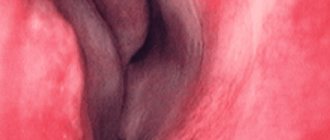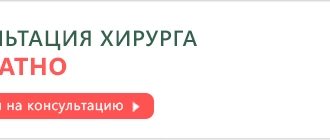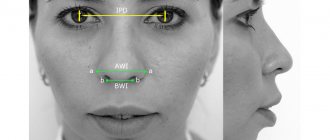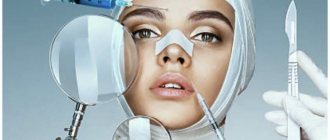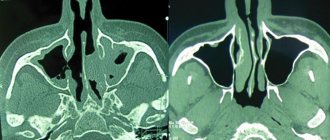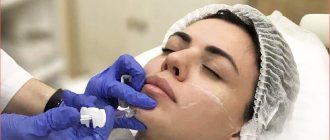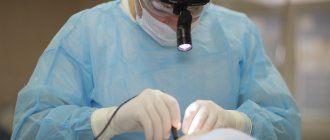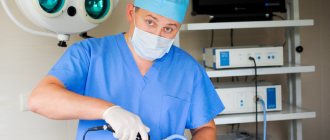Septoplasty of the nasal septum can be performed using different methods, one of which is laser septoplasty (correction of the nasal septum). Laser nasal septoplasty is one of the modern methods of correcting the nasal septum, and has found many followers in the form of some rhinosurgeons.
When performing laser septoplasty, a rhinosurgeon can use different types of laser scalpels. In this case, the doctor sets the required temperature of the laser treatment.
- The advantages of laser septoplasty include:
- Prevention of hemorrhages by sealing blood vessels with a laser;
- Prevention of infection. When performing laser septoplasty, there is no risk of introducing bacteria into the human body;
- The entire correction lasts no more than half an hour.
Rhinoplasty plastic surgeon comments:
“This method implies that the laser is used as a scalpel or as a vascular coagulator. It can also be used to eliminate excess tissue by burning it.”
Laser septoplasty: patient reviews
Many patients of our clinic admitted that only after septoplasty did they understand what it means to “breathe deeply.”
Indications for laser septoplasty:
- Impaired nasal breathing function;
- Snoring and other sounds when inhaling through the nose;
- Frequent nosebleeds;
- ENT diseases: sinusitis, sinusitis, rhinitis;
- Chronic runny nose;
- Nasal congestion.
Disadvantages of laser septoplasty
- For severely deviated nasal septum, the laser method is ineffective. In such cases, the surgeons of our clinic use the endoscopic or classical method of septoplasty.
- The method has been used relatively recently. Scientists have not yet fully studied how the nasal septum will behave after surgery, and what consequences are possible in the future.
- Laser scalpels for septoplasty are expensive equipment, so laser septoplasty a priori cannot be cheap.
For severely deviated nasal septum, the laser method is ineffective
In most cases, problems with the nasal septum require a radical solution. Curvatures exclusively in the area of cartilage tissue occur much less frequently. Typically, deformation of the nasal septum involves working with bone tissue, which is beyond the power of a laser scalpel.
“I am aware of my responsibility; my patient may not be embarrassed or afraid of “stupid questions”, because they do not exist! The main thing is that there is understanding and complete trust on his part and on mine. Then, in the end, together we will be proud of the work we have done.”
Tamarov Alexey Nikolaevich plastic surgeon
What is rhinoplasty?
Rhinoplasty , or nose job, is one of the most popular procedures in plastic surgery. The nose is the optical center of the face, attracting the eye first. Correction of the shape of the nose of a congenital nature (for example, if it is necessary to remove a nasal hump ) or resulting from an injury changes the face, deprives it of expressiveness, and sometimes disfigures it, leading to painful experiences, negative psychogenic reactions, and separates a person from society.
Contraindications
Contraindications to the procedure are determined individually after examination/consultation and a comprehensive examination of the patient. Conditions for which laser correction is not recommended include:
- exacerbation of general somatic chronic diseases;
- inflammatory or infectious lesions of the skin of the nose;
- blood diseases (clotting disorders);
- oncology of various etiologies and localizations;
- diabetes mellitus in the stage of decompensation;
- epilepsy;
- severe mental disorders (schizophrenia);
- pregnancy and breastfeeding;
- impaired skin regeneration and a tendency to form keloid scars;
- fresh tan;
- decreased general and local immunity.
Important! Doctors recommend that smoking patients give up cigarettes at least for the period of rehabilitation after laser nose resurfacing. Since nicotine significantly impedes the blood supply to tissues, the skin healing process in smokers can take longer and be more difficult than in non-smokers.
Indications for rhinoplasty
- Nasal breathing problems;
- Deviation of the nasal septum
- Deformation after injury, correction of a displaced nasal septum;
- Long or wide nose;
- Aquiline nose;
- The thickened tip of the nose also requires plastic surgery;
- Large nostrils;
- Unsuccessful result of a previous operation.
The best age for nose correction is from 18 to 45 years old, and this is due to the characteristics of the cartilage tissue of the nose. Before the age of 18, it is not advisable to perform the operation, since the nasal skeleton is not yet fully formed, and after 45, age-related growth of cartilage tissue occurs, and it becomes more difficult to predict the final result.
Do not forget about a number of contraindications to rhinoplasty : severe diseases of internal organs, acute and chronic cardiovascular diseases, diabetes mellitus, bleeding disorders, bronchial asthma, cancer, systemic diseases (rheumatism, lupus erythematosus, etc.).
Preparation before surgery
The operation can be performed after laboratory tests and diagnostic examinations:
- general urine and blood tests;
- blood chemistry;
- blood test for infections;
- blood test for coagulation (coagulogram);
- checking blood sugar levels;
- ECG and fluorography.
The list is expanded by the doctor’s decision if there are appropriate indications in the patient’s medical history.
In addition, patients should prepare for surgery several days in advance by avoiding:
- taking pharmaceutical drugs that affect blood clotting (Aspirin, Heparin, Diclofenac, Indomethacin, etc.);
- drinking alcohol and smoking.
Preparation of male patients also includes removal of facial hair.
Postoperative period
First week after rhinoplasty : A hospital stay at the clinic is required for 1-3 days. After just 1-2 days, tampons are removed from the nasal passages - do not be alarmed if, in the first days after their removal, the feeling of nasal congestion persists after correction. Swelling of the skin and eyelids after nose surgery reaches its maximum on days 2-3, but already from the 6-10th day the swelling begins to decrease. It is not recommended to eat hot food for the first week after surgery. After 3-5 days, you can take cool showers and baths, but the bandage should remain dry. Second week after rhinoplasty : 7-10 days after the nose correction, the plaster cast is removed, after which you can use makeup. After 10-14 days, you can return to social activity, your usual activities and light physical activity. Further period : Try to protect your nose after correction from various injuries. It is not recommended to wear glasses for 4-6 weeks after surgery. During the first 1-2 months after correction of the nose (including the tip), the sensitivity of the skin of the nose and upper lip may decrease, but do not worry, the sensitivity will return on its own by the end of the recovery period. Cosmetic procedures such as peeling and elos rejuvenation can be performed within 3 weeks. But sports and active physical activity can be restored only after 2-3 months.
Techniques
Surgery can be performed with appropriate anesthesia. If the curvature affects tissues and structures without involving the bone part, then general anesthesia is not necessary. In this case, local anesthesia is sufficient. When interfering with bone structures, the operation will be performed under general anesthesia. The method of pain relief can also be complex.
Modern surgery offers several ways to perform surgery. Here the classic surgical method and laser surgery to correct the nasal septum stand out. In this case, the traditional use of a scalpel involves resection of the submucosa without external incisions. Mechanical action with a scalpel is carried out in the nasal cavity. An endoscope is used to enhance control.
In this way, superficial correction of the cartilage or straightening of the bone part is possible. Due to the fact that the incisions are only on the mucous membrane inside the nasal passages, the final aesthetic effect is very high. There are no visible seams, and subsequently scars, here.
Laser septoplasty, as the name suggests, involves the use of a laser. This operation is possible in the presence of minor disorders that do not affect the bones.
Laser surgery is carried out in two ways:
- Correction of the septum using a laser scalpel, which cuts healthy tissue for subsequent removal of excess processes and curvatures.
- Correction by bringing the septum to a state of plasticity by heating it with a laser to a high temperature. Then it is mechanically given the desired shape. This method may also be called septochondrocorrection.
Characteristics and advantages of laser technology:
- in this case, local anesthesia is used;
- low level of complexity of the operation, the duration of which should not take more than half an hour;
- there are no incisions or deep tissue damage, so the operation is considered bloodless;
- Based on the previous paragraph, it follows that tampons, turunds or gel are not used after surgery;
- the cauterizing and at the same time antiseptic effect of the laser guarantees the absence of further infection and also promotes healing;
- due to the characteristics described above, the rehabilitation period after surgery does not last long and can be carried out on an outpatient basis without round-the-clock supervision;
- The aesthetic appearance of the patient during the recovery period does not suffer, since there are no severe swelling and hematomas.
Possible complications and evaluation of results after rhinoplasty
Remember that rhinoplasty is one of the most complex plastic surgeries, so it is necessary to take the recommendations of the plastic surgeon both before the operation and in the postoperative period.
The most common complications after rhinoplasty
- Subcutaneous hematomas under the eyes (dissolve on their own within 1-2 weeks). Most often, this complication occurs in patients who smoke;
- Inflammation of soft tissues - most often in patients with reduced immunity;
- Hypertrophic scars at the site of sutures - with an individual tendency to form hypertrophic scars.
The picture that appears after removing the plaster cast is far from the final result. Depending on the rhinoplasty method and individual characteristics, the skin of the nose may remain swollen and slightly red for up to 4 months after the shape correction surgery. However, this swelling is hardly noticeable to those around you, so as soon as your cast is removed and the hematomas go away, you can safely return to work. The long recovery period must be treated with understanding - after all, when changing the shape of the nose and plastic surgery of the tip of the nose, complex anatomical structures are affected, the restoration of which requires a lot of time. It will be possible to evaluate the final result only after 6-10 months, when a new osteochondral skeleton is formed. But the result is worth a little discomfort?
Indications
Laser nose resurfacing is a minimally invasive cosmetic procedure that is designed to remove excess skin thickness, as well as non-surgical correction of other skin deformities, including scars. One of the most common reasons for turning to professional cosmetologists is the disease rhinophyma - a consequence of chronic pathology - rosacea.
Note: rhinophyma is an abnormal growth of epidermal tissue, provoked by a pathological proliferation of small blood vessels in the skin of the nose (rosacea). The disease is much more often detected in men and manifests itself as thickening of the tip and dorsum of the nose, followed by distortion of its shape. Patients who are not ready to put up with such an appearance resort to the services of specialists to get rid of a pronounced, literally, defect.
In addition, laser nose resurfacing can eliminate the effects of acne, smooth out or completely remove post-traumatic/postoperative scars and scars, narrow enlarged pores and improve the condition of the skin in general.
Revision rhinoplasty
According to various studies, rhinoplasty is one of the three most popular operations in aesthetic surgery, along with breast augmentation and liposuction. Huge demand, as we know, creates supply. A huge number of surgeons, without proper training, undertake these operations in such a highly complex section as rhinosurgery. The “echoes of war” are hundreds of injured patients and lawsuits. But the unsuccessful result of rhinoplasty does not always depend on the inept actions of the surgeon. Often the reason for unsuccessful rhinoplasty is the individual characteristics of the body or the patient’s failure to comply with the doctor’s recommendations.
The difficulty of revision rhinoplasty is due to changes in the anatomical location of tissues after the first operation. Often, during revision rhinoplasty, is faced with the problem of complete or partial absence of cartilage after the “work” of the previous surgeon. The operating surgeon must have fundamental knowledge in the field of reconstructive rhinosurgery.
Plastic surgeons at the MedEstet Aesthetic Medicine Clinic have extensive experience in correcting such problems and will “work on mistakes.” You can sign up for a free consultation, find out the cost of rhinoplasty and get answers to all your questions by phone.
*The cost of the operation includes: stay in the clinic for the first day after the operation + 3 meals a day. Further stay with meals – 8,000 rubles/day.
Laser septoplasty: price in Moscow
The cost of laser septoplasty depends on many factors: the degree and nature of the deformation of the nasal septum, the experience and qualifications of the doctor, as well as the level of equipment of the clinic. The use of expensive equipment, of course, also affects the price of laser septoplasty.
| Name | Price |
| Septoplasty | 80,000 rub. |
| Stay in the observation room (up to 3 hours) | 3,000 rub. |
| Primary appointment (examination, consultation) with a plastic surgeon | FOR FREE |
If you go to a public clinic to see your ENT doctor with problems of difficulty breathing, sinusitis, severe snoring or frequent nosebleeds, then if a deviated nasal septum is detected, septoplasty can be performed under the compulsory medical insurance policy. However, in most cases this is a paid operation. As for laser septoplasty, the possibility of performing this operation depends on the level of technical equipment of the clinic. The average price for laser septoplasty of the nasal septum in Moscow is 56,500 rubles.
Surgeons at our clinic perform both separate surgical correction of the nasal septum and septoplasty combined with rhinoplasty (aesthetic nose surgery). Our specialists adhere to proven surgical methods of septoplasty, which allows us to achieve a well-predicted and high-quality result of septoplasty.
